Enhanced corneal cross-linking procedure an effective keratoconus treatment
The Keraflex procedure flattens the cornea and regularizes its shape while the cross-linking maintains biomechanical integrity.
Click Here to Manage Email Alerts
 Arthur Cummings |
Corneal cross-linking has been shown to be effective at slowing the progression of keratoconus. Varying reports on improvement in corneal shape with cross-linking exist, but the improvements are typically modest. At this juncture, we know that cross-linking is successful at stopping the progression of keratoconus, despite the corneal shape being less than ideal.
The ideal scenario is one in which you first improve the corneal shape and then “lock” this new shape in with cross-linking. This has been achieved by combining topography-guided PRK with cross-linking and combining Intacs (Addition Technology) or other intrastromal rings with cross-linking. PRK removes tissue in an already thinned cornea, and although this has proven to be very successful in the right patient, removing tissue is still counterintuitive in the keratoconic eye. Placing intrastromal segments into an already weakened cornea is also somewhat counterintuitive.
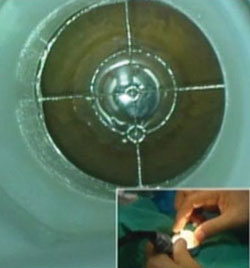 Figure 1: The applicator ring centered over the corneal apex. |
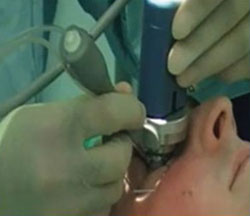 Figure 2: The microwave handpiece, positioned and engaged into the targeting stage. Images: Cummings A |
Using thermal effects to reshape the cornea improves corneal shape without removing tissue and without placing segments into weakened tissue.
Personal experience
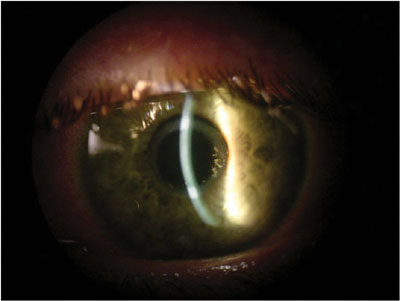 Figure 3: A slit-lamp view of the typical day 5 postoperative appearance. The bandage contact lens is still in situ and the thermal ring can clearly be seen centrally. |
At my clinic, the Avedro Vedera system has been extremely effective at flattening the cornea and regularizing the corneal shape through the Keraflex procedure, which flattens the central cornea without compromising its biomechanical integrity. The Vedera and Keraflex KXL systems are CE marked but not yet approved for use in the U.S. by the U.S. Food and Drug Administration.
During a Keraflex procedure, the Vedera system delivers a single low-energy microwave pulse lasting less than 1 second. Energy is applied to the cornea using a dielectrically shielded microwave emitter, which noninvasively contacts the epithelial surface. Through capacitive coupling, the single pulse raises the temperature of the selected region of corneal stroma to approximately 65° C, shrinking the collagen and forming a toroidal lesion in the upper 150 ìm of the stroma below Bowman’s membrane.
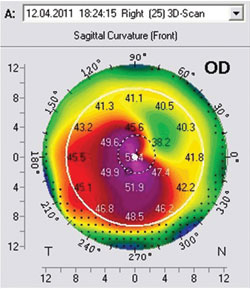 Figure 4: Pentacam preoperative baseline results. The preoperative Pentacam demonstrating central steepness of more than 75 D. |
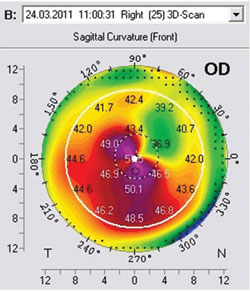 Figure 5: Pentacam 5 days postoperative results. Day 5 postoperative Pentacam demonstrating central keratometry readings in the low 50s – this represents central flattening of more than 20 D. |
Using Keraflex in my clinic, flattening from 10 D to 30 D has been achieved and in all cases has resulted in significant improvements in uncorrected visual acuity. In October 2010, four eyes were treated and all received traditional cross-linking via the standard Dresden protocol from 4 days to 7 days after the Keraflex procedure, which stabilized and locked in the effect that was achieved by Keraflex. There was regression of between 5 D and 10 D of corneal power between the Keraflex procedure and the corneal cross-linking application during the 4 days to 7 days after Keraflex.
Since the corneal cross-linking application, two of the four eyes have flattened further, one appears stable, and the fourth has regressed by 2 D further in 6 months. All eyes are still at least 10 D flatter than they were prior to Keraflex.
Further research
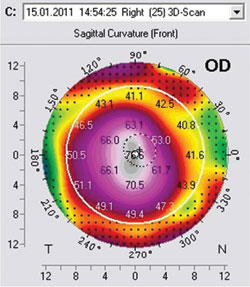 Figure 6: Pentacam 1-month postoperative results. Month 1 postoperative Pentacam shows very minimal regression of the initial effect with the central keratometry readings still in the low 50s. |
In March 2011, six eyes received Keraflex and simultaneous KXL accelerated cross-linking. In these cases, the patients’ eyes were soaked with 0.1% isotonic riboflavin for 8 minutes, followed by 3 minutes of ultraviolet A exposure. (Note that soak time can be reduced further when using the KXL for accelerated cross-linking or Avedro LASIK Xtra as standalone procedures, not in conjunction with Keraflex).
Using the KXL system, accelerated cross-linking is achieved by delivering the same energy density (5.4 J/cm²) as a traditional cross-linking system, but is faster due to higher power output (30 mW/cm² vs. 3 mW/cm²).
An example of the immediate effect of Keraflex plus KXL can be seen on the topographies, and the improvements are dramatic. It remains to be seen whether the simultaneous use of KXL results in a different postoperative course than sequential cross-linking a few days later. At this early stage, it appears that simultaneous KXL results in much less regression of the initial Keraflex flattening. In one case (Figures 1 to 6) there has been just over 1 D of regression in the first 4 weeks, whereas in the sequential cases regression was approximately 10 D. I am not sure what can be attributed to the timing element (earlier cross-linking intervention) and what can be attributed to the higher-power KXL.
In my experience, I have not had a tool with as much power to change the corneal shape positively and with such a good safety profile as the Vedera system offers with the Keraflex procedure. If the initial early postoperative course as seen here continues with further stabilization of the corneal shape, I predict that Keraflex will become an important adjunctive procedure in the corneal surgeon’s arsenal.

- Arthur Cummings, MD, FRCS, can be reached at Wellington Eye Clinic, UPMC Beacon Hospital, Dublin, Ireland; +353-1-2930470; fax: +353-1-2935978; email: abc@wellingtoneyeclinic.com.
- Disclosure: Dr. Cummings has no relevant financial disclosures.
